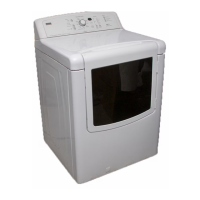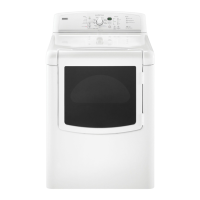Do you have a question about the Kenmore Oasis 110.77042600 and is the answer not in the manual?
Important safety information for dryer operation and user protection.
Explains the structure and meaning of model and serial numbers.
Identifies the physical locations of model/serial number labels and tech sheets.
Outlines the terms and conditions of the one-year limited warranty.
Guidance on tools, parts, and steps for installing the dryer.
Specifies necessary site conditions and space for dryer installation.
Details recommended spacing around the dryer for proper operation and ventilation.
Specific installation guidelines for mobile homes, including venting and hardware.
Details electrical supply, wiring, and connection requirements for electric dryer models.
Essential guidelines for proper grounding of the dryer to prevent electrical shock.
Step-by-step instructions for connecting the dryer's power supply.
Presents choices for connecting the dryer's electrical supply based on home wiring.
Detailed steps for connecting a 4-wire power supply cord to the dryer.
Instructions for directly wiring the dryer using a 4-wire cable.
Steps for connecting a 3-wire power supply cord to the dryer.
Instructions for directly wiring the dryer using a 3-wire cable.
Procedure for optional 3-wire connection where codes prohibit cabinet-ground to neutral.
Electrical safety and connection requirements specific to gas dryer models.
Specifications and recommendations for the gas supply line connection.
Specifications and recommendations for the gas supply line connection.
Guidelines for connecting the gas supply, including fittings and compound.
Considerations for burner input based on elevation.
Procedure for testing gas supply pressure safely.
Information about the dryer's gas pipe connection size.
Recommended materials and types for dryer exhaust venting to prevent fire hazards.
Recommended materials and types for dryer exhaust venting to prevent fire hazards.
Guidance on using elbows for airflow and clamps for sealing vent joints.
Recommended styles for dryer exhaust hoods to prevent entry of pests and debris.
Guidance on planning the dryer's exhaust vent system.
Typical and alternative dryer exhaust venting configurations.
Information on kits for alternative dryer exhaust venting setups.
Steps to plan the most efficient and straightest dryer vent path.
Chart detailing vent material and hood combinations for optimal drying performance.
Step-by-step guide for installing the dryer's exhaust vent system.
Instructions for adjusting the dryer's leveling legs for stability.
Procedure for connecting the gas supply to gas dryer models.
Final steps for connecting the dryer's vent to the exhaust outlet.
How to check and adjust the dryer's levelness after installation.
Instructions for changing the dryer door's swing direction from right to left.
Steps for safely removing the dryer door and its hinges.
Procedure for moving the door strike to the opposite side for a reversed door swing.
Detailed steps for reattaching the dryer door after reversing its swing.
Final checks and initial operation steps after installing the dryer.
Basic guidance for operating the dryer and understanding its controls.
Basic steps to power on and begin a drying cycle.
How to select and use automatic drying cycles based on fabric type and dryness level.
How to select and use timed drying cycles with specific drying durations.
Instructions on how to pause, stop, or restart the dryer cycle.
General advice and tips for optimal drying and fabric care.
Explanation of the dryer's status lights and their meaning.
Information about the lint screen reminder light.
Overview of different drying cycles available and their applications.
How to use the Heavy Duty cycle for heavyweight items and cottons.
Usage guide for the Cotton/Towels cycle for heavy fabrics.
Instructions for using the Normal cycle for sturdy fabrics.
How to use the Bulky/Bedding cycle for large items.
Usage guide for the Casual cycle for no-iron and synthetic fabrics.
Instructions for the Ultra Delicate/Delicate cycle for fragile items.
A table outlining settings for automatic drying cycles.
Explanation of how to use timed drying cycles and adjust time.
Use of the Timed Dry cycle for items still damp or for heavy items.
How to use the Express Dry™ cycle for small loads needing quick drying.
Using the Touch Up cycle to smooth wrinkles.
Adjusting dryness level and temperature settings for cycles.
How to use the Air Dry cycle for items that should not be dried with heat.
Customizing cycles with options like Drum Light, Damp Dry Signal, Wrinkle Guard.
How to turn the drum light on and off.
Using the Damp Dry Signal to alert when items are approximately 80% dry.
How Wrinkle Guard® helps smooth out wrinkles after the cycle ends.
Adjusting the volume of the cycle end signal.
How to modify cycle settings before starting.
Steps to change cycle settings after the dryer has already started.
How to change settings if you realize a mistake after the cycle begins.
How to adjust the default dryness level for automatic cycles.
Instructions for using the dryer rack for items that should not tumble.
Table of suggested items, cycle settings, and times for using the dryer rack.
Identifies the location of major internal components within the dryer.
Location of electronic controls and user interface parts.
Location of components found in the lower section of the dryer.
Location and identification of components within the gas burner system.
Step-by-step guide to remove key electronic control components.
Procedure for accessing and removing the dryer's moisture sensor.
Steps to detach the front panel and access the door switch.
Instructions for removing the internal drum light component.
Guide to accessing and removing the thermal fuse and outlet thermistor.
Steps to remove the high-limit thermostat, inlet thermistor, thermal cutoff, and electric heater.
Procedure to remove thermostats, sensors, and the gas burner assembly.
Steps to remove the dryer drum, belt, and support rollers.
Guide to accessing and removing the blower fan in single-motor configurations.
Procedure for removing the blower motor and fan in dual-motor setups.
Steps to remove the main drive motor and the belt switch.
How to test the door switch for proper functionality using an ohmmeter.
Procedures to test the thermal fuse and outlet thermistor with an ohmmeter.
Testing procedures for high-limit thermostat, inlet thermistor, thermal cutoff, and electric heater.
How to test the gas burner coils for continuity using an ohmmeter.
Procedure for testing the burner ignitor's resistance with an ohmmeter.
Method to test the flame sensor for continuity.
Testing procedures for gas model thermostats and thermal cutoffs.
How to test the blower motor resistance in dual-motor configurations.
Procedure to test the belt switch for continuity and open circuit.
Comprehensive tests for the drive motor windings, thermal overload, and centrifugal switch.
Table of error codes displayed by the dryer and their explanations/solutions.
Essential checks and preparation before performing diagnostic tests.
Steps to enter the dryer's diagnostic test mode.
Testing the functionality of console buttons and indicator lights.
Checks for door switch, moisture sensor, and console ID recognition.
How to view and interpret inlet airflow readings in diagnostic mode.
How to check the dryer's incoming line voltage in diagnostic mode.
Steps to perform a manual load test on the dryer's components.
Table correlating problems with possible causes and tests.
Verifying continuity of power cord connections to the terminal block.
Checking if power is present at the machine control and if it is functional.
Testing the wiring and continuity of the drive motor circuit.
Testing the blower motor resistance and connections in dual-motor units.
Diagnosing issues related to the dryer not heating or overheating.
Testing the exhaust thermistor for proper resistance and functionality.
Checking the inlet thermistor's resistance at various temperatures.
Checking the continuity of the thermal fuse.
Verifying the status of the thermal cut-off.
Testing the gas valve coil for proper resistance.
Diagnosing moisture sensor issues on gas dryers.
Troubleshooting console buttons and indicator lights.
Testing the door switch functionality using diagnostic mode.
How to adjust the dryer's automatic cycle settings for customer preference.
Step-by-step instructions for removing the front panel and drum assembly.
Steps to access electronic components for diagnostics.
Error codes specific to gas dryers and their troubleshooting.
Pre-test checks and entering diagnostic mode for gas dryers.
Console checks for gas dryers including door switch, sensor, and component IDs.
Checking incoming line voltage for gas dryers in diagnostic mode.
Common problems and potential causes for gas dryers.
Verifying power cord connections for gas dryers.
Checking machine control power and functionality for gas dryers.
Testing the drive motor circuit for gas dryers.
Testing the blower motor on dual-motor gas dryers.
Diagnosing heating issues specific to gas dryers.
Testing the exhaust thermistor on gas dryers.
Checking the inlet thermistor resistance on gas dryers.
Testing the thermal fuse on gas dryers.
Verifying the thermal cut-off on gas dryers.
Diagnosing moisture sensor issues on gas dryers.
Troubleshooting console buttons and indicators for gas dryers.
Testing the door switch on gas dryers using diagnostic mode.
Electrical schematics showing connections for single and dual element electric dryers.
Simplified wiring diagrams for motor and blower systems.
Simplified wiring diagram for the single-element heater circuit.
Simplified wiring diagram for the dual-element heater circuit.
Schematic showing electrical connections for gas dryer models.
Simplified wiring for gas dryer motor and blower systems.
Simplified wiring for gas dryer heater and gas valve systems.
Wiring diagrams for moisture sensor, centrifugal switch, and motor switch.
Wiring diagram for the gas valve components.












